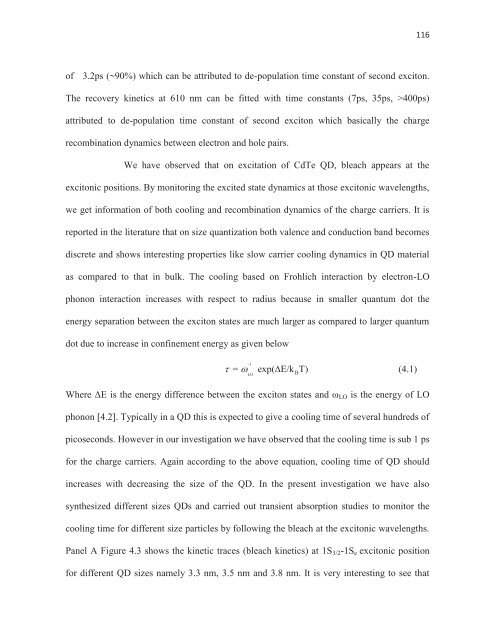CHEM01200604009 Sreejith Kaniyankandy - Homi Bhabha ...
CHEM01200604009 Sreejith Kaniyankandy - Homi Bhabha ...
CHEM01200604009 Sreejith Kaniyankandy - Homi Bhabha ...
Create successful ePaper yourself
Turn your PDF publications into a flip-book with our unique Google optimized e-Paper software.
116<br />
of 3.2ps (~90%) which can be attributed to de-population time constant of second exciton.<br />
The recovery kinetics at 610 nm can be fitted with time constants (7ps, 35ps, >400ps)<br />
attributed to de-population time constant of second exciton which basically the charge<br />
recombination dynamics between electron and hole pairs.<br />
We have observed that on excitation of CdTe QD, bleach appears at the<br />
excitonic positions. By monitoring the excited state dynamics at those excitonic wavelengths,<br />
we get information of both cooling and recombination dynamics of the charge carriers. It is<br />
reported in the literature that on size quantization both valence and conduction band becomes<br />
discrete and shows interesting properties like slow carrier cooling dynamics in QD material<br />
as compared to that in bulk. The cooling based on Frohlich interaction by electron-LO<br />
phonon interaction increases with respect to radius because in smaller quantum dot the<br />
energy separation between the exciton states are much larger as compared to larger quantum<br />
dot due to increase in confinement energy as given below<br />
-1<br />
= exp( E/k<br />
LO<br />
BT)<br />
(4.1)<br />
Where ΔE is the energy difference between the exciton states and ω LO is the energy of LO<br />
phonon [4.2]. Typically in a QD this is expected to give a cooling time of several hundreds of<br />
picoseconds. However in our investigation we have observed that the cooling time is sub 1 ps<br />
for the charge carriers. Again according to the above equation, cooling time of QD should<br />
increases with decreasing the size of the QD. In the present investigation we have also<br />
synthesized different sizes QDs and carried out transient absorption studies to monitor the<br />
cooling time for different size particles by following the bleach at the excitonic wavelengths.<br />
Panel A Figure 4.3 shows the kinetic traces (bleach kinetics) at 1S 3/2 -1S e excitonic position<br />
for different QD sizes namely 3.3 nm, 3.5 nm and 3.8 nm. It is very interesting to see that
















